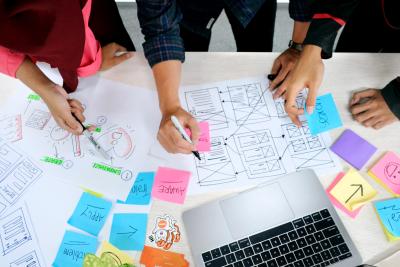
By Meag Doherty, SSI Fellow
Following RSECon22, I visited London and Cambridge for a week of talks and meetups. My tour included Turing Institute’s AI for multiple long-term conditions: Research Support Facility (RSF), Imperial Research Software Community, and EMBL's European Bioinformatics Institute.
My primary goal was to collect success stories from the research software engineering community about implementing positive user experiences*. What I got instead was the opposite. Tales of negative user experiences in RSE projects and what we can do about it.
*User experience (UX) is an end user's experience with a product or service.
‘I am the user; I know what I want”
There are RSEs, who are the researcher and the software engineer, building a fit-for-purpose solution for themselves. These RSEs may be content with their way of working and only consider investing in positive user experience once a project grows beyond their single use case.
‘I understand the value of good UX, but I’m not sure where to begin’
Some RSEs have moved into software engineering from research posts and have had limited exposure to specific UX design processes. At each of my talks, I heard variations of I want to ‘do UX; where do I start?
One way to get started: Know your audience. Wherever you arrive at a project, get clear on the user goals and how those goals will be or are measured. Once you clarify the goals, identify where you might be falling short on such goals. For a full list of activities at this stage, visit the section ‘Start with real user needs’ on Design Principles from the U.S. Web Design System website. And for RSE-specific approaches, stay tuned for [link to blog post #1 where I mention Ginestra’s work])
‘I understand the value of good UX, and I know how to get started, but I am stuck’
And for many RSEs, implementing good user experiences remains out of reach. While the reasons why are varied, one thing rang true throughout,
RSE projects tend to start too quickly and end too soon.
From the start of an RSE project, the predetermined project lifecycle skews towards technical requirement gathering instead of user needs and goals. These techno-centric processes can lead to a technically functional solution that does not fully serve its purpose. And the work ends when the MVP is delivered, which often lacks user-friendly features. One RSE reflected on the lack of continuation beyond the minimum product:
“Developing UI is not on the path of success for researchers.”
What’s Next
Do you have reflections about open source research software development, usability, and design to share? Superbloom Design, supported by the Sloan Foundation, is investigating how open-source teams consider usability and design in their work. They're collecting responses to this compensated survey through January 2023.
Want to discuss this post with us? Send us an email or contact us on Twitter @SoftwareSaved.

